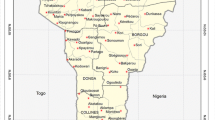Abstract
One approach to improve cotton (Gossypium hirsutum L.) yield is to identify stable genotypes for low or no bollworms damage as it accounts low cost of cultivation to a considerable extent. The objective of the study was to identify stable genotypes for low bollworms damage under protected and unprotected experiments. Fifty cotton (Gossypium hirsutum L.) genotypes were evaluated for open bollworms damage percent (spotted, pink and Heliothis bollworms) for 3 years during 2003–2005 under protected and unprotected conditions. Variance due to genotypes, environments, genotype × environment and genotype × environment (linear) components were highly significant for the trait in protected and unprotected experiments. Under protected experiment, genotypes CSH 3020 and 3045 were found to be desirable and stable while genotype CSH 3058 was suited for poor environments. Fourteen genotypes viz. CSH 3034, 3035, 3043, 3044, 3047, 3051, 3053, 3058, 3059, 3094, 3106, 3114, 3123 and CSH-3157 were fairly stable under unprotected environments. The study lead to the conclude that in general for the two experiments the genotypes differed for stability for low bollworms damage.



Similar content being viewed by others
References
Allard RW, Bradshaw AD (1964) Implications of genotype–environmental interactions in applied plant breeding. Crop Sci 4:503–507
Becker HB, Leon J (1988) Stability analysis in plant breeding. Plant Breed 101:1–23
Bhat MG, Kohel RJ, Altman DW (1990) A study on host plant resistance to bollworms (Heliothis spp.) in cotton using tissue isogenic lines. J Cotton Res Dev 3:140–146
Culp TW, Hopkins AR, Taft HM (1979) Breeding insect resistant cottons in South Carolina Agricultural Experiment station Technical Bulletin 1074, Clemson, 11 pp
Eberhart SA, Russell WA (1966) Stability parameters for comparing varieties. Crop Sci 6:36–40
Finlay KW, Wilkinson GN (1963) The analysis of adaptation in plant breeding programmes. Aust J Agric Res 14:742–754
Grover A, Pental D (2003) Breeding objectives and requirements for producing transgenics for major field crops of India. Curr Sci 84:310–320
Gupta SC, Ndoye AT (1991) Yield stability analysis of promising pearl millet genotypes in Senegal. Maydica 36:83–86
Hebert Y, Plamion C, Harzic N (1995) Genotype × environment interaction for root traits in maize as analysed with factorial regression models. Euphytica 81:85–92
Jones JE, Dickson JI, Burris E, Clower DF, Caldwell WD, Marshall JG, Stringer SJ (1988) Registration of three insect resistant cotton germplasm lines. Crop Sci 28:200
Mather K, Jinks JL (1982) Biometrical genetics. Chapman Hall Ltd., London
Murray JC, Verhalen LM (1970) Genotype × environment interaction study of cotton in Okalhoma. Crop Sci 10:197–199
Nizam JR, Shroff VN, Patel VG, Dahholkar AR (1988) Phenotypic stability of single and three way hybrids of cotton with respect of their yield components. J Indian Soc Cotton Improv 13:118–123
Paroda RS, Hays JD (1971) Investigation of genotype–environment interactions for rate of ear emergence in spring barley. Heredity 26:157–176
Pham HN, Kang MS (1988) Interrelationships among respectability of several stability statistics estimated from international maize trials. Crop Sci 28:925–928
Pund MM, Dev DV (2006) Stability of yield and other quantitative traits in upland cotton. J Cotton Res Dev 28(2):181–184
Ramachandran K, Joshi LS, Menon CB (1980) The cost of cotton pest control in India. Outlook Agric 10:208–209
Tuteja OP, Singh DP, Chabra BS (1999a) Phenotypic stability for yield and its component traits in Asiatic cotton hybrids. J Indian Soc Cotton Improv 24(1):10–13
Tuteja OP, Singh DP, Chabra BS (1999b) Genotype × environment interaction on yield and quality traits of Asiatic cotton (Gossypium arboreum). Indian J Agric Sci 69(3):220–223
Tuteja OP, Singh M, Verma SK (2006) Stability analysis for seed cotton yield and its component traits in intrahirsutum hybrids of Gossypium. J Cotton Res Dev 20(2):171–173
Virk DS, Chahal SS, Pooni HS (1985) Repeatability of stability estimators of downy mildew in pearl millet. Theor Appl Genet 70:102–106
Author information
Authors and Affiliations
Corresponding author
Rights and permissions
About this article
Cite this article
Ahuja, S.L., Jeyakumar, P. & Dhayal, L.S. Stability analysis for bollworm complex in Gossypium hirsutum L.. Euphytica 161, 313–318 (2008). https://doi.org/10.1007/s10681-007-9504-5
Received:
Accepted:
Published:
Issue Date:
DOI: https://doi.org/10.1007/s10681-007-9504-5




